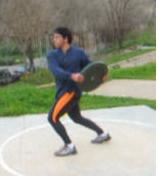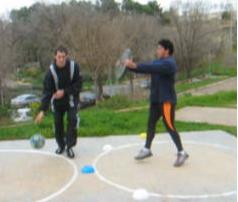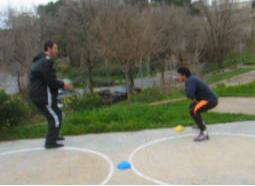| |
ED
10 / ebc 2 - ST 10 / pc 2 Models
of Strength Training Sessions
LECTURE
Ribera-Nebot,
David (2005). Models of Strength Training Sessions.
International Basketball Clinic Vilnius. July 8-10th,
2005. Vilnius (Lithuania).
Lithuanian
Basketball Coaches Association
Lithuanian
Basketball Federation
MODELS
OF STRENGTH TRAINING SESSIONS
David
Ribera-Nebot
Barcelona University
Basketball Coach (Spanish basketball coaches association
-superior coach since 1987-)
Physical conditioning coach of the Spanish under-20 basketball
national team 2002
Introduction
It
was an honour and a great experience to participate in this
Lithuanian Basketball Clinic.
Thank you very much for your attention.
I strongly hope my lecture could provide you practical
proposals for the basketball players you coach.
Feel
free
to contact me: basketball@movementsciences.com
All
the proposals are based on pratical theories learned from my
best professor Francisco Seirul·lo Vargas.
In the following web page I present his publications on sport
training: http://www.entrenamientodeportivo.org
There is already in English one of his articles on "Adjuvant
Training".
Soon I will introduce one of his articles on strength
training ("Strength training in handball") in which
you will find the basics to construct different levels of
specific strength exercises.
In the
following web page: http://www.humanmovement.com
you can find an article on a practical experiences of strength
training ("Strength training of the Spanish
basketball team fot the 6th European basketball championship
for young men 2002").
|
|
| |
Lecture Outline
I present a list of the main concepts in order
to have a guide of the examples showed in practice. Thus,
every coach will be able to create his/her own practices.
- Model
for General Strength Training Session
A circuit of 3-6 exercises is repeated 2-4 times.
Each exercise consists of:
1. Basic General Strength Exercise
2. Applied Exercise
3. Compensatory Exercise (adjuvant training)
Practice example with 4 exercises:
a) figthing strength (1,2,3)
b) jumping strength (1,2,3)
c) throwing strength (1,2,3)
d) running strength (1,2,3)
At the end: coordination skills (motor control with
enphasis on kinestesic discrimination).
- Model
for Directed Strength Training Session
A set of 2-4 areas are repeated 2-4 times.
Each area consists of:
1. Basic Directed Strength Exercise type a)
2. Basic Directed Strength Exercise type b)
3. Basic Directed Strength Exercise type c)
4. Compensatory
Exercise (adjuvant training)
Practice example with 2 areas:
A) 1.figthing, 2. jumping, 3.throwing, 4.adjuvant
exercises
B) 1.figthing, 2. short movement, 3.running, 4.adjuvant
exercises
- Model
for Special Strength Training Session
1-4 sequences are repeated 4-10 times.
Each sequence consists of 4-8 basic special strength or
speed exercises.
At the end: adjuvant exercises.
Practical example with 1 sequence:
1. Fighting and short movement special strength exercise
2. Figthing and short movement speed-coordination (light
overload) -"cross the zone"
3. Jumping special strength exercise and speed for
rebounding
4. Running special strength exercise and speed for
changing direction
5. Running special strength exercise and speed for
dribbling zig-zag
6. Speed-coordination for starting short movement (without
and with dribbling)
7. 1 on 1 (1/4 court)
-
Level 1-General Strength (General Strength 1-2): consisted of
multi-jumps, multi-runs, multi-throws, multi-“fights” and
multi-short movements exercises for all players with movement
control emphasis.
PHOTO
(Dani Pérez). Example of Fighting Strength (Level 1).

-
Level 2-Directed Strength (Special Strength 1-2): consisted of
exercises for running, fight, short movements and long pass;
distinguishing between interior and exterior players (point
guard-small forward and power forward-center); and with the
emphasis on spacial-temporal factors. The strength tests are
considered Level 2-Directed Strength.
PHOTO
(Santi Abad & Dani Pérez). Example of Fighting Strength (Level
2).

- Level 3-Special
Strength (Special Strength 3-4): consisted of a combination of
3-6 actions selected among running, fighting and short
movement; distinguishing between interior and exterior players
(point guard-small forward and power forward-center); and
emphasizing on the decision making strategies and programming
processes.
PHOTO (Santi Abad
& Dani Pérez). Example of Fighting Strength (Level 3).

-
Speed. Speed training could be considered Level 4-Competitive
Strength and consisted of selected basketball actions (runs,
short movements, starting movements, “fights”, “fight”
plus another action, dribbling, jump plus tip and long-short
pass) performed under cognitive and coordination variations.
Speed practices were independent or a part of a strength
practice.
|
|